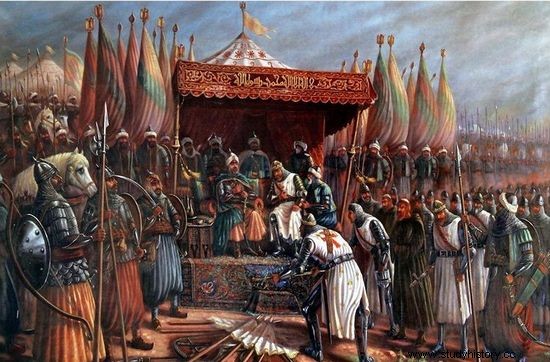In the history of the crusades, a strict image of the two conquests of Jerusalem has become established. The Crusaders ruthlessly bathed the city in blood when they captured it in 1099. In 1187, Saladin, on the other hand, was to be completely civilized and to guarantee the population a safe exit from their homes and a march to the coast. Even in Europe, there were later legends of his forbearance. Of course, nothing is black and white in history. In fact, Saladin approached Jerusalem in a totally… business fashion.
Saladin - the sultan of Egypt and Syria (1174–1193), the founder of the Ayyubid dynasty - was not a particularly brutal or impulsive man. On the other hand, he had, like every militant ruler, considerable financial needs. When the richest and most important city of Christians in the Holy Land fell into his hands, he immediately saw a chance to earn money .
Muslim flags hung over Jerusalem on October 2, 1187. It was then that Saladin ordered guards and officials responsible for collecting the ransom to be set up at each gate. As Piotr Solecki, the author of Saladin's new biography, explains, the whole city was taken prisoner, from which anyone could buy out, if only they had money (p. 133) . Thus, each of the thousands of captured Jerusalem residents received a bill to pay. In many cases the tallest in his life.

The conquest of Jerusalem was an excellent opportunity for Saladin to earn a huge ransom money that every Christian wishing to leave the city had to pay.
Saladin behaved as befits a skilled businessman :he set a proper price list and entered into negotiations with the defeated. Anyone who did not pay the ransom within a month was to be sold into slavery. Initially, the sultan wanted 20 gold coins (bezants) for each man, 10 for woman, and 5 for a child, as Jean Richard writes about in The Crusades. Truly astronomical sums!
After long negotiations, he went down to roughly 4 bezants for each man. The deal involved 7,000 people, but it is not known how many bought out and how many were unable to do so. Apparently, in addition to the inhabitants of Jerusalem, the invaders also found 20,000 refugees from other cities within its walls.
A penny to a penny…
According to Muslim accounts, the Patriarch of the Church of Jerusalem Heraclius seized the first opportunity and at the cost of a lot of valuables he fled the city regardless of the fate of his flock. The Jerusalem magnate, Balian of Ibelin, was supposed to behave more honorably, allegedly buying up several thousand prisoners from his own purse.
Saladin collected huge sums from the ransom, but even those sums did not cover all the expenses. In this situation, he began to look for other sources of income . Admittedly, Muslims closed the Church of the Holy Sepulcher right after their seizure of the city, but it was reopened after a few days. The only thing that has changed is that now the entrance fee costs - a trifle - 10 zlotys.
The Sultan also allowed the Jewish population to return to the holy city. As Piotr Solecki explains in the book "Saladin and Crusades", it was not associated with another manifestation of kindness, but with a tax that they had to pay you (p. 134) . Likewise, when Saladin released all the old men, he was not at all pity. It's just that such people were worthless as slaves, they had no money for the ransom, and it was for him that the cost of feeding them fell.
What if the scoop has not collected?
Contrary to the candy vision we remember from the movie "Kingdom of Heaven", not all the inhabitants of Jerusalem managed to pay for their freedom and security. For many, on October 2, the lifetime horror begins, which casts a long shadow on images of the "civilized" conquest of Jerusalem by Saladin.

Still from the movie "Kingdom of Heaven" (2005).
One Syrian Christian reported what happened in the captive capital of the Kingdom of Jerusalem:
Words will not describe the crimes that were committed in the city and that we witnessed; how holy places were sold to people of all races; how churches and altars became stables for horses and cows and places of execution, singing and fun.

Add shame to monks, noble women, nuns who were disgraced by different people, boys and girls who became Turkish slaves and were scattered to the four corners of the world ("Saladin and the Crusades," p. 137).
Even more touching and no doubt authentic is the story of the Muslim, Imad ad-Din:
They had to get used to the humiliation […] 8,000 women and children were quickly divided among us, their cries sparked smiles on Muslim faces. How many women have been defamed! [...] House-dwelling women became public, free women enslaved […]. The beauties were put to the test, virgins were defamed, proud women were humiliated, the red lips of the beauties were kissed, […] the happy ones were forced to cry. […] How many worthy ladies were sold at low prices, and relatives were sent to distant places ("Saladin and the Crusades," p. 138).
And so history once again verifies what pop culture has taught us.
Sources:
Basic:
- Piotr Solecki, Saladin and the crusades , Replica, 2011.
Complementary:
- Jean Richard, The Crusades, c.1071 – c.1291 , Cambridge University Press, 1999.
